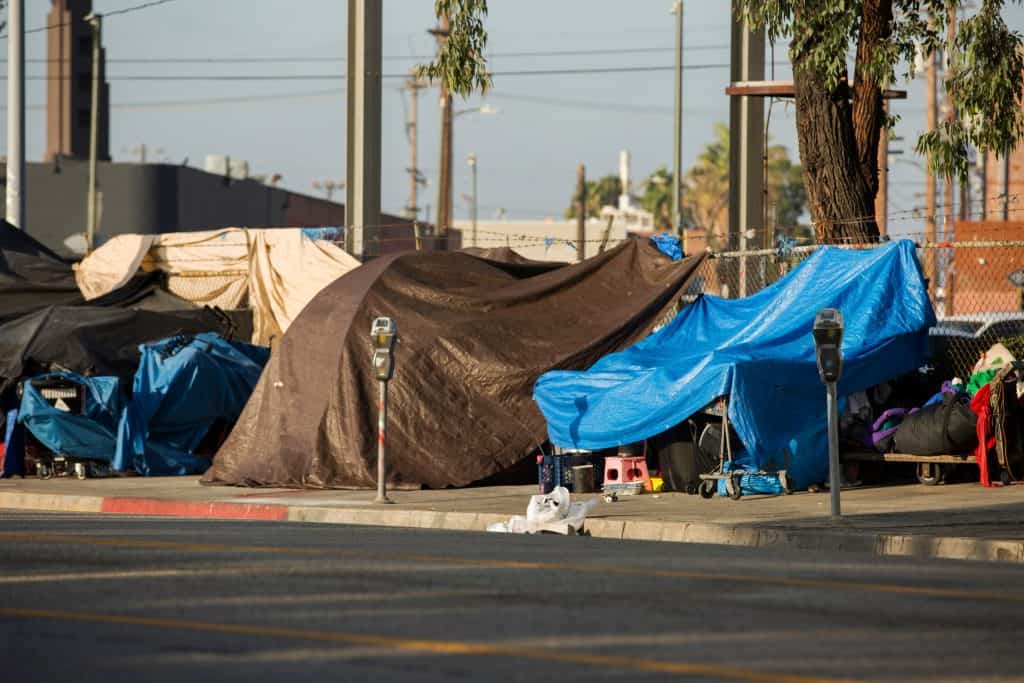
by Richard Schulman
Why is homelessness most severe in states and cities controlled by progressives? Most states reduced homelessness in 2018 and 2019. But nationally, homelessness increased by 3% in 2019. How is that possible?
The answer, as noted in Forbes, is that
The national increase is primarily due to a leap in homelessness in California where it grew 16.4% between 2018 and 2019 or by 21,306 people. In terms of absolute numbers, California has more than half of all unsheltered homeless people in the country at 53%,…nearly nine times as many as the state with the next highest number.
A pattern repeated in cities and courts
At the municipal level, the five cities with the largest homeless population, in descending order, are New York City, Los Angeles, Seattle/King County, San Jose/Santa Clara city and county, and San Diego city and county. All five jurisdictions are progressive dominated, albeit San Diego less so than the others.
What makes progressives so adept at creating homeless populations? One could start with the progressive judiciary of the Ninth Circuit Court of Appeals. That court, covering the western United States, ruled that homeless encampments are a de facto constitutional right. The court’s decision was written by Judge Marsha S. Berzon, appointed by Bill Clinton; and concurred in by Judges Paul J. Watford and John B. Owens, both of whom clerked for Supreme Court Justice Ruth Bader Ginsberg and were appointed by President Obama. (Judge Owens concurred but with a partial dissent.)
Two types of homeless persons
The homeless population can be divided into two broad categories. In the first category are addicts and the mentally ill, who make up the majority of the homeless. “Homelessness is an addiction crisis disguised as a housing crisis,” the City Journal reports. “[T]he City of Seattle’s homeless-outreach team estimates that 80 percent of the unsheltered population has a substance-abuse disorder.”
The second, smaller category of homeless are the economic casualties – those who could no longer meet rent or mortgage payments and thus were forced into the streets.
Progressive policies nourish both categories .
The addicted and mentally ill
Seattle’s Obama-allied LGBT mayor is in denial of the addiction numbers supplied by her own police department and city attorney.
Los Angeles “fails to provide access to on-demand detox, rehabilitation, and recovery programs that might help people overcome their addictions” — City Journal writes — “compounded by permissive policies toward public camping and drug consumption….No matter how much local governments pour into affordable-housing projects, homeless opioid addicts—nearly all unemployed —will never be able to afford the rent in expensive West Coast cities. The first step in solving these intractable issues is to address the real problem: addiction.”
In addition to addiction, many in the first category are also mentally ill, victims of the deinstitutionalization policies begun in the 1960s during the Kennedy and Johnson administrations. An Ohio study estimated that thirty percent of the homeless are mentally ill. A later study put the figure at 45%.
The economic casualties
Progressive policies also nourish the second, smaller category, those who are homeless for economic reasons. Housing in progressive jurisdictions is prohibitively expensive and in short supply because of restrictive zoning and land use policies, burdensome building codes, and high union labor costs. In some jurisdictions, rent control and restrictions on landlord property rights discourage the creation of new rental properties.
While high housing costs are one blade of the scissors shearing the economic homeless, the other blade is the decline of manufacturing employment in California. California has the highest income inequality of any state in the union. High taxes, high minimum wages, and high electricity costs — made especially expensive by solar and wind-generation mandates – are some of the many incentives for industries to move elsewhere. The consequence is that the working population is divided between a reasonably well-paid technology and financial sector and a low paid service sector, some of whom are in the US illegally.
Densification
Progressives do have a housing plan – densification. It has nothing to do with addressing the homeless problem but rather is aimed at weakening the family oriented, Republican-leaning suburbs. Accordingly, Virginia Democrats are calling single-home ownership “racist” and “bad for the environment.” Meanwhile, The Nation, grand-daddy of US progressive publications, asserts that “California’s fires prove the American Dream Is flammable. If we want to keep cities safe in the face of climate change, we need to seriously question the ideal of private home ownership.”
Under densification, Americans will be “nudged” to move from the too white, too Republican or independent suburbs into apartments in the reliably-Democratic cities. Densification will have the collateral benefits
- of discouraging ownership of fossil-fuel guzzling automobiles in favor of mass transit,
- discouraging couples from having children, that “burden” on the planet, and
- insure that the few children still produced — despite unrestricted abortion — will be educated by progressive teachers in unionized urban public schools.
Downsized living alongside the homeless
Thus private home ownership in the ‘burbs will give way to collective life in high-rise hutches on the Chinese model. But because there is nothing in it for the homeless under this partisan plan, the densified citizenry will continue to live side by side with the encamped homeless, their bodily waste products, schizophrenic mutterings, threatening gestures, and used needles.

Leave a Reply